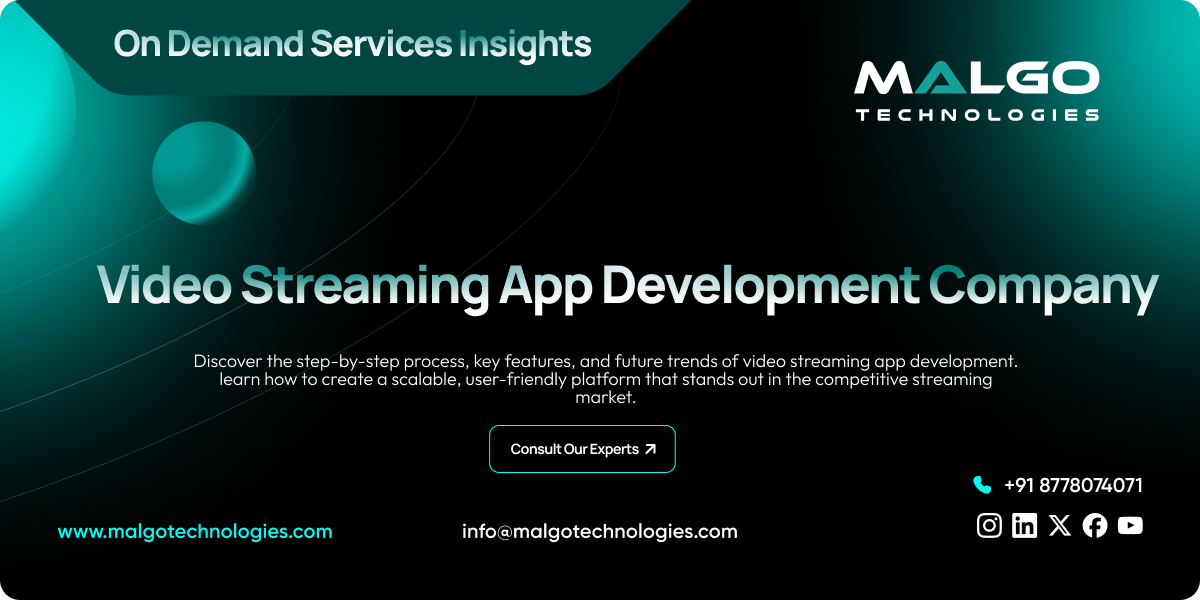Why Video Streaming Apps Are in Demand?
The global shift toward digital content consumption, fueled by the rise of smartphones, high-speed internet, and smart TVs, has significantly boosted the demand for video streaming apps. Users now expect seamless access to their favorite content anytime, anywhere, setting platforms like Netflix, Hulu, and YouTube as the standard in a highly competitive market.
Over the past decade, video consumption has surged as users transition from traditional TV to digital platforms. Whether for entertainment, education, or live events, streaming applications offer unmatched flexibility and instant access to content, making them indispensable in today’s digital landscape.
Why Invest in Video Streaming App Development?
Investing in a video streaming app offers access to a highly lucrative market. Whether you aim to create a niche platform or compete with industry giants, a well-designed app can generate revenue through subscriptions, ads, or pay-per-view models. While the cost varies depending on the features and customization needed, opting for ready-made scripts tends to be more cost-effective than custom development, making it an ideal choice for those looking to maximize profitability.
Businesses and content creators are capitalizing on streaming technology to expand their reach and boost engagement. The demand for video content is higher than ever, and platforms that offer seamless streaming capabilities are attracting large audiences and revenue opportunities.
Overview of the Video Streaming Industry in 2025
By 2025, the video streaming industry is projected to grow exponentially, driven by advancements in AI, cloud technologies, and 5G connectivity. Emerging trends like AR/VR integration and blockchain-based content distribution are set to redefine user experiences. AI-driven recommendations and immersive content will continue to evolve, while 5G will enhance video quality, reduce buffering times, and enable real-time interactions. These innovations together will shape the future of streaming, offering more dynamic and personalized viewing experiences.
What Is a Video Streaming App?
A video streaming app allows users to watch videos over the internet without downloading them. These platforms use cloud-based infrastructure and content delivery networks (CDNs) to deliver high-quality media efficiently.
Key Features of a Successful Streaming App
- High-definition video playback with adaptive bitrate
- User-friendly interface with content categorization
- Multi-device compatibility
- Secure payment gateways
- AI-powered recommendations
- Real-time analytics for content performance
Types of Video Streaming Apps
On-Demand Streaming Apps
Platforms like Netflix and Hulu allow users to access a vast library of content anytime.
Live Streaming Apps
Apps such as Twitch and YouTube Live focus on real-time broadcasting, ideal for gaming and events.
Peer-to-Peer (P2P) Streaming Apps
Decentralized platforms that enable direct streaming between users, enhancing security and reducing bandwidth costs.
TV & Sports Streaming Apps
ESPN and DAZN provide access to live sports events, replays, and exclusive content.
Social Media Streaming
Facebook Live and Instagram Live integrate video streaming with social interactions, increasing audience engagement.
Common Features of a Video Streaming App
User-Friendly Interface:
Intuitive design for seamless navigation and user experience.
Multi-Platform Compatibility:
Support for web, mobile (iOS & Android), and smart TVs.
High-Quality Video Playback:
Supports 4K, HDR, and adaptive streaming for smooth playback.
Content Search and Recommendations:
Advanced search functionality and personalized content suggestions.
Offline Viewing and Downloads:
Allows users to download content for offline access.
User Profiles and Personalization:
Multiple user profiles with personalized watchlists and preferences.
Social Sharing and Interaction:
Share content on social media and interact with other users.
Subscription and Payment Integration:
Secure payment gateways for subscriptions and pay-per-view options.
Analytics and Reporting:
Track content performance and user engagement metrics.
Advanced Features of a Video Streaming App
AI-Based Personalization:
AI-driven recommendations based on user behavior and preferences.
Live Chat and Interactive Features:
Real-time chat and interactive elements for live streaming events.
Multi-Device Synchronization:
Seamless switching between devices with synchronized progress.
Cloud Storage and Content Management:
Cloud-based storage for scalable content management.
Security and DRM (Digital Rights Management):
Protects content from piracy with encryption and DRM.
Adaptive Bitrate Streaming:
Adjusts video quality based on internet speed for uninterrupted playback.
Multi-Language and Subtitle Support:
Offers content in multiple languages with subtitle options.
Integration with Third-Party Apps:
Connects with social media, smart home devices, and other platforms.
Advanced Analytics for Content Creators:
Provides creators with insights into viewer demographics and engagement.
Video Streaming Application Development Services
Custom Streaming App Development
Building solutions tailored to specific business needs, ensuring unique branding and user experience.
White Label Solutions
Ready-made scripts that can be customized with branding, reducing time to market and development costs.
Live Streaming Solutions
Developing applications capable of real-time broadcasting with interactive features such as live chat and audience polls.
OTT (Over-the-Top) Platform Development
Designing platforms similar to Netflix or Disney+ with subscription models and content management systems.
Video-on-Demand (VOD) Solutions
Building scalable solutions for businesses looking to offer a curated content library with monetization options.
Core Technologies Behind Video Streaming Apps
Frontend Development (React, Angular, Swift, Kotlin)
Frontend technologies ensure a smooth and responsive user interface across devices.
Backend Development (Node.js, Django, Ruby on Rails)
The backend handles data storage, user authentication, and content delivery.
Database Solutions (MySQL, MongoDB, Firebase)
Databases store user data, content metadata, and analytics.
Video Hosting and Delivery (AWS Media Services, Azure Media Services)
Cloud-based hosting ensures reliable and scalable content delivery.
Content Delivery Networks (CDNs)
CDNs reduce latency by distributing content across multiple servers.
Streaming Protocols (HLS, MPEG-DASH, RTMP)
These protocols ensure smooth video playback across devices and networks.
Development Process: Building Your Video Streaming App
Market Research and Competitor Analysis
Identify your target audience and analyze competitors.
Defining the Target Audience and Use Cases
Understand user preferences and design features accordingly.
Choosing the Right Monetization Model
Decide between subscriptions, ads, pay-per-view, or a hybrid model.
Wireframing and UI/UX Design
Create a user-friendly interface with seamless navigation.
Backend and Frontend Development
Build the app's core functionality and integrate streaming protocols.
Testing and Quality Assurance
Ensure the app is bug-free and performs well under high traffic.
Launching the App and Post-Launch Support
Deploy the app and provide ongoing updates and support.
Challenges in Video Streaming App Development
Ensuring Low Latency for Live Streaming
Minimize delays to provide real-time experiences.
Handling High Traffic and Scalability
Use cloud infrastructure and CDNs to manage traffic spikes.
Maintaining Video Quality Across Devices
Optimize video encoding for different resolutions and devices.
Data Security and DRM (Digital Rights Management)
Protect content from piracy and unauthorized access.
Compliance with Legal and Licensing Requirements
Ensure your app adheres to copyright laws and regional regulations.
Monetization Strategies for Video Streaming Apps
Subscription-Based Model (SVOD)
Users pay a recurring fee for unlimited access to content.
Advertisement-Based Model (AVOD)
Revenue is generated through ads played before or during content.
Pay-Per-View (TVOD)
Users pay for individual content pieces.
Freemium Model
Basic content is available for free, with premium content behind a paywall.
Sponsored Content & Partnerships
Revenue generated through collaborations with brands and influencers.
Cost to Develop a Video Streaming App
The cost depends on the features and customization required. Ready-made scripts are more cost-effective than custom development. Factors affecting costs include:
- App complexity and features
- Platform compatibility (iOS, Android, Web)
- Development team location
- Maintenance and updates
Future Trends in Video Streaming App Development
- AI-powered personalized recommendations
- AR/VR integration for immersive experiences
- Growth of niche streaming platforms
- 5G enhancing streaming quality
- Cloud-based streaming solutions
- Blockchain for secure content distribution
Why Partner with Malgo for Video Streaming App Development?
Malgo is a leading developer of video streaming solutions, providing end-to-end development services. With expertise in advanced streaming technologies, Malgo ensures high-performance applications tailored to business needs. Whether building from scratch or using white-label solutions, Malgo delivers scalable and secure platforms for various industries.
Malgo combines technical expertise, industry experience, and a client-centric approach to deliver top-notch video streaming solutions. From concept to launch, we ensure your app stands out in a competitive market.
Launch your video streaming app with Malgo—contact us today to get started!
Frequently Asked Questions
User-friendly interface, high-quality playback, content recommendations, and multi-platform support.
Development time varies based on features, complexity, and customization.
DRM, encryption, and multi-layer authentication ensure content protection.
Yes, hybrid models combining subscriptions, ads, and pay-per-view options are common.
Apps can be built for iOS, Android, web, and smart TVs.


